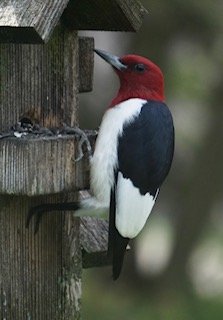Naturally
I did a Breeding Bird Survey for the U.S. Geological Survey in Freeborn, Mower and Steele Counties. The lowlights were the stable flies. The highlights were many, but seeing trumpeter swans, sandhill cranes and red-headed woodpeckers topped the list. I saw several red-heads. Are woodpeckers educated at the school of hard knocks? The male red-headed woodpecker does most of the excavation of nest cavities and completes the project in 12–17 days.
I watched robins in the yard. Two males battled at the edge of their territories. One appeared to be slightly larger than the other and won every battle. I reckon the burly bird gets the worm.
I watched two crows, about twice the length of a blue jay, mosey across the lawn. They stopped occasionally to vocalize. I don’t think crows ever grow tired of being crows. I rarely see a dead crow on the road, but I found one I could tell was a young crow because of its blue eyes. It hadn’t learned to fear the speed of a car.
I’m seeing fireflies. In the butterfly world, I’m enjoying the brownish colors of skippers and crescents.
Several studies have found that mosquitos may prefer to bite individuals with Type O blood over other blood types. It’s important to note that a number of factors may influence a person’s chances of getting bitten: hormones, carbon dioxide emission, perfumes, alcohol intake and more.
Summer offers more blooming flowers in prairies, fields and ditches, and outside the woods where I found flowers blooming in the spring. White (bladder) campion is a European species that provides white flowers from May to September.
Q&A
“How long do squirrels live?” Red squirrels live 3-10 years in the wild, with only about 25% living longer than a year. Fox squirrels 8-18 years in the wild, flying squirrels 3-5 years and grey squirrels live 6-12 years.
“What ants could I have in my house?” They could be your aunts. Aunts are gift-bearing, often bringing food, and should be welcomed. Carpenter ant workers are 3/16-1/2 inch long. They don’t eat wood, but nest in moist or rotting wood. Cornfield ants are light to dark brown and workers are 1/10-1/8 inch long. Common in the soil in exposed areas, forming small craters several inches wide, especially in lawns where the grass has thinned or is bare. They feed on sweets including honeydew and are sometimes found feeding on honeydew from insects infesting houseplants. Field ants are black, brown, red or combinations of those colors. Workers range in size from 1/8-1/4 inch long. Some make large mounds, up to 10 inches across. They also nest under objects, such as wood, stones and patio blocks. They don’t nest inside buildings. Pavement ants are reddish-brown to black and 1/8 inch long. They nest in soil under sidewalks, driveways, stones and logs, and are commonly found under homes with concrete slab construction. Pharaoh ants are 1/16 inch long and light yellow to red with a darker colored thorax and can be confused with thief ants. They feed on a wide variety of foods, especially those containing grease or fats, and also feed on many types of sweets, dead insects, toothpaste and soap. They nest in cracks and crevices behind countertops, baseboards, wall voids, and other small openings. Thief ants, often called grease ants, are the smallest household ants found here. They nest near the nests of larger ants and steal their larvae. Thief ants are yellow to light brown and are 1/20 inch long. They prefer protein and greasy foods, such as meats, cheese, peanut butter and nuts, but also eat sweets. They are small enough to enter almost any type of food container and can nest indoors in small spaces under countertops, wall voids, cabinet voids and behind baseboards.
“What birds other than the loon were considered as Minnesota’s state bird?” Before the legislature decided on the common loon as Minnesota's state bird in 1961, several other birds were suggested, including the eastern goldfinch (1947), the mourning dove (1951), the pileated woodpecker (1951 and 1953), the scarlet tanager (1951) and the wood duck (1951). Erratic swimmers are the loon’s favorite since it makes them easy to catch. Loons eat a lot of yellow perch, bluegill, pumpkinseed and crayfish.
“Is Absorbine Jr. good for keeping mosquitoes away?” I have heard from people that Absorbine Jr., a pain reliever designed to help aching muscles and joints, works for them as a mosquito and gnat repellent, but I’ve not tried it.
Thanks for stopping by
“If the world were a big apartment, we wouldn’t get our deposit back.”—John Ross.
“You must live in the present, launch yourself on every wave, find your eternity in each moment.”—Henry David Thoreau.
Do good.
©Al Batt 2022
Does a red-headed woodpecker learn all it needs to know at the school of hard knocks? Photo by Al Batt.

